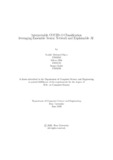| dc.contributor.advisor | Alam, Md. Ashraful | |
| dc.contributor.advisor | Reza, Md. Tanzim | |
| dc.contributor.author | Dipto, Shakib Mahmud | |
| dc.contributor.author | Afifa, Irfana | |
| dc.contributor.author | Kabir, Sumya | |
| dc.date.accessioned | 2021-09-16T18:34:45Z | |
| dc.date.available | 2021-09-16T18:34:45Z | |
| dc.date.copyright | 2021 | |
| dc.date.issued | 2021-06 | |
| dc.identifier.other | ID: 17101153 | |
| dc.identifier.other | ID: 18101316 | |
| dc.identifier.other | ID: 17101298 | |
| dc.identifier.uri | http://hdl.handle.net/10361/15023 | |
| dc.description | This thesis is submitted in partial fulfillment of the requirements for the degree of Bachelor of Science in Computer Science and Engineering, 2021. | en_US |
| dc.description | Cataloged from PDF version of thesis. | |
| dc.description | Includes bibliographical references (page 25-28). | |
| dc.description.abstract | COVID-19 which is also none as Corona Virus Disease is rst discovered in a city
of China named Wuhan at December 2019 and it has been announced as a global
pandemic at the middle of 2020. SARS-CoV-2 virus COVID-19 and that can also
act as a trigger to cause respiratory tract infection ranging from mild to deadly.
According to experts, this virus may also infect the upper respiratory system, which
includes the sinuses, nose, and throat, as well as the lower respiratory system, which
includes the windpipe and lungs. The disease can infect other people via respiratory
droplets and coming near to the COVID-19 infected people as well as touching those
objects of surfaces which are the virus contaminated. Nowadays, millions and millions
of people across the globe are su ering from this disease causing a huge death
rate. Even after taking serious precaution measures, the number of patients dealing
with this disease and the death toll is still rising at a drastic rate. In this paper,
we approach a fast and e ective measure to detect COVID-19 using CT scan images.
First, we collected data and classi ed using VGG16, VGG19, E cientNetB0,
ResNet50 and ResNet152. Form our result; we got an accuracy rate of 85.33% from
VGG16, 87.86% from VGG19 and 82.35% from ResNet101. Then we formed an ensemble
model with these best three classi ers and achieved a best overall accuracy
rate of 90.89% from COV19EXAI V1 and 91.82% from COV19EXAI V2. Finally,
we integrated XAI in our model to achieve a better understand of our classi cation. | en_US |
| dc.description.statementofresponsibility | Shakib Mahmud Dipto | |
| dc.description.statementofresponsibility | Irfana A fifa | |
| dc.description.statementofresponsibility | Sumya Kabir | |
| dc.format.extent | 28 pages | |
| dc.language.iso | en | en_US |
| dc.publisher | Brac University | en_US |
| dc.rights | Brac University theses are protected by copyright. They may be viewed from this source for any purpose, but reproduction or distribution in any format is prohibited without written permission. | |
| dc.subject | COVID-19 | en_US |
| dc.subject | Corona Virus | en_US |
| dc.subject | CV19AA | en_US |
| dc.subject | Deep Neural Network | en_US |
| dc.subject | VGG | en_US |
| dc.subject | Inception V3 | en_US |
| dc.subject | ResNet | en_US |
| dc.subject | Ensamble Modeling | en_US |
| dc.subject | VGG16 | en_US |
| dc.subject | VGG19 | en_US |
| dc.subject | ResNet50 | en_US |
| dc.subject | ResNet101 | en_US |
| dc.subject.lcsh | COVID-19 (Disease) | |
| dc.title | Interpretable COVID-19 classification leveraging ensemble neural network and explainable AI | en_US |
| dc.type | Thesis | en_US |
| dc.contributor.department | Department of Computer Science and Engineering, Brac University | |
| dc.description.degree | B. Computer Science | |

